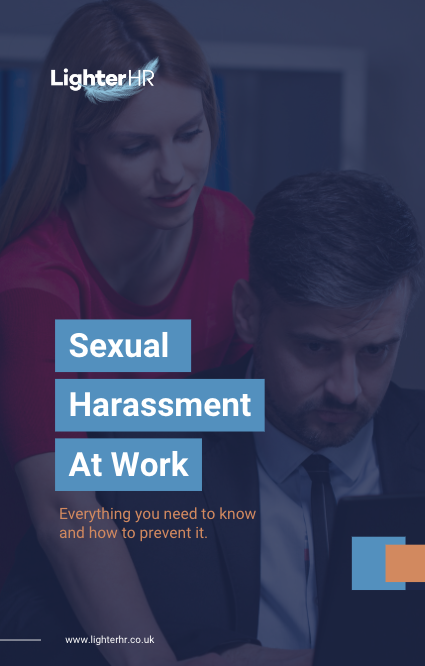From 26th October 2024, employers have a statutory duty under the Worker Protection Amendment of Equality Act 2010 to take action to prevent sexual harassment in the workplace.
Employers will be legally required to reduce the chance of sexual harassment happening in the workplace. The emphasis will move from dealing with complaints in an appropriate manner to preventing the harassment happening in the first place.
Failure to comply could incur hefty financial penalties. Tribunals will be able to increase compensation by up to 25% for employers who fail to do all they can to prevent sexual harassment in the workplace.
This change acts as a wakeup call for businesses who have potentially felt that an Equality Policy and some online training was sufficient to be able to say they’d done all of the right things. There are now far stricter requirements and paying lip service to the issue will not be sufficient.
Time to read our post: 5 minutes
The questions answered in this post are:
1. Why Are Changes to Sexual Harassment Legislation Being Introduced?
This new duty to prevent sexual harassment represents increasing awareness that the current measures are inadequate.
Protection against sexual harassment already exists under the Equality Act 2010. However, employers haven’t been obliged to take preventative steps. What this has often done, is allow harassment to continue until a complaint is raised. This is too late to prevent harm from occurring both to individuals and the organisation.
Sexual harassment at work can have awful outcomes, making for a toxic environment that demoralises staff. It drives away talent as often times this type of behaviour does become the subject of Glassdoor reviews or social media content. It also opens businesses up to costly tribunal claims.
In addition, reputational damage, which can come from mishandling incidents of this nature, mustn’t be underestimated.
Julie Dennis, Head of Inclusive Workplaces Policy at ACAS has said: “Even employers acting in good faith with anti-harassment policies and zero-tolerance posters may still get caught out by claims of harassment”.
The sad reality is that policies aren’t enough. Employers should create an environment in which employees feel protected from sexual harassment, safe reporting any harassment that does occur and confident that their concerns will be dealt with sensitively.
2. What Do Employers Need to Do to Comply with Preventing Sexual Harassment Laws?
Under the new law, all employers, from SMEs to large corporations, have a duty to take proactive measures to prevent sexual harassment in the workplace. But what are considered ‘reasonable steps’? Below are the key areas businesses need to review:
i. Conduct a Comprehensive Risk Assessment
A thorough risk assessment should be the first, and arguably most important step in understanding the risk your organisation faces.
Employers must identify areas where sexual harassment might occur, including:
- Work environment: Is there minimal supervision if activities are off-site, during late shifts, or when some employees work from home?
- Power imbalances: Is your organisation characterised by hierarchies that could allow specific people to exploit their influential status?
- Third-party risks: Do your staff interact directly with third-party clients, customers, or suppliers, which exposes them to the risk of harassment from a third party? Whilst third-party harassment is not explicitly addressed in the new law, there’s still an expectation that employers manage this risk. By identifying these risks early, businesses can implement customised solutions to address vulnerabilities, specific to their operations or circumstances.
ii. Review and Update Sexual Harassment and Associated Policies
Anti-harassment and discrimination policies should be well-framed, updated regularly, and above all, accessible to employees.
Policies should clearly state what constitutes sexual harassment, outlining the organisation’s zero-tolerance position and detailing complaint, reporting and actioning procedures.
But having the policies themselves is not enough.
Employers have to:
- Make their preventing sexual harassment policies available through a company-wide training campaign and make sure it’s part of everyday working life.
- Incorporate these policies in employment handbooks and (where necessary) widen the anti-harassment clauses through third-party contracts to include clients and suppliers.
- Review social media, lone-working policies and grievance procedures so they’re all revised to take account of these new obligations.
We also recommended conducting regular audits on such policies to ensure their effectiveness and accuracy.
iii. Implement Training Programmes
Training is probably one of the best ways to prevent sexual harassment, but it needs to be more than a box-ticking exercise.
Under the new duty, businesses should provide bespoke training for all employees, reflecting the specific issues posed by their particular environment.
- General Training: It should be clearly and regularly explained to all employees what is meant by ‘undesirable behaviour’, the sanctions for harassment, and the mechanisms in place for reporting concerns.
- Manager-Specific Training: All managers should be trained in sensitive and effective responses to complaints. It would cover early signs of harassment, how to investigate, and take care of their teams.
Training is not a one-off event but an ongoing process, especially when an organisation experiences a high turnover of staff. It’s also important to note that off-the-shelve training may not be sufficient on its own. There is a requirement for training to be delivered that highlights the specific risks in your organisation.
We recommend that you ensure senior management are actively participating in these training sessions, to send a clear message that the organisation takes this issue seriously.
iv. Create Effective Reporting Mechanisms
A very important component of creating a culture where the incidence of harassment is prevented is making sure that there are multiple avenues through which employees can report concerns and that the avenues are easily accessible.
The reporting mechanisms should:
- Be confidential, thus providing protection for employees against reprisals.
- Be anonymous, when possible, for example, through whistleblowing hotlines or external providers, such as ourselves.
- Be supported by staff who are trained either in-house or externally and who are competent to receive sensitive complaints.
Employers should audit their complaints processes on a regular basis to ensure they are working as they were designed. Monitoring trends along with early intervention also has the effect of preventing other issues from escalating for a business.
v. Foster a Positive Workplace Culture
Ultimately, preventing sexual harassment is about culture. Organisations should aim for a culture rooted in dignity, respect, and inclusivity.
Achieving this requires active engagement from senior leadership, regular communication with employees, and embedding anti-harassment values throughout every aspect of the business.
3. What are the Consequences of Non-Compliance?
Non-compliance with the new law carries significant risks.
Employment tribunals may now uplift compensation by up to 25% if an employer is found to have breached their duty to take reasonable steps to prevent harassment from happening.
Compensation for sexual harassment claims can be very high, so such an uplift might have very serious business consequences.
Lastly, the Equality and Human Rights Commission (EHRC) will have the powers to investigate breaches and order employers to take action through enforcement notices as well as to demand action plans from them.
In our experience, investigations can cause as much reputational damage as penalties because of the high-profile nature of cases.
4. How Can LighterHR Help You Prepare for the Changes?
At LighterHR, we understand the challenges in keeping up to date with constantly changing legislation. As HR consultants, we’re well-positioned to help your business prepare for this new duty of care in preventing sexual harassment.
Our services include the following:
- Comprehensive Risk Assessments: Our consultants will conduct a full assessment of your workplace-a comprehensive investigation into possible risks and advise on how best to mitigate these.
- Policy Audits: We conduct thorough reviews of the policies that exist to provide robust, updated, and fully compliant policies with new legislations.
- Bespoke Training: From general staff training to specific sessions for managers, we can create tailored programmes that address the needs of your organisation and the workforce.
- Outsourced HR Services: We provide the opportunity to outsource your HR function which gives you an external and entirely independent third party, whom employees can feel safe coming to. Sexual harassment complaints are handled with confidentiality and neutrality in order to minimise internal biases and mismanagement that could further aggravate the situation. This brings confidentiality and credibility to the table, making employees confident to speak freely without fear of retribution. We create secure, impartial, and discreet reporting channels that promote transparency yet protect your business from any issues that may arise.
As we approach the October 2024 deadline, now is the time to act. If you’re in need of assistance with this transition, book a free consultation and let’s chat about how we can help.

Need help to deal with implementing the changes to Sexual Harassment legislation?



